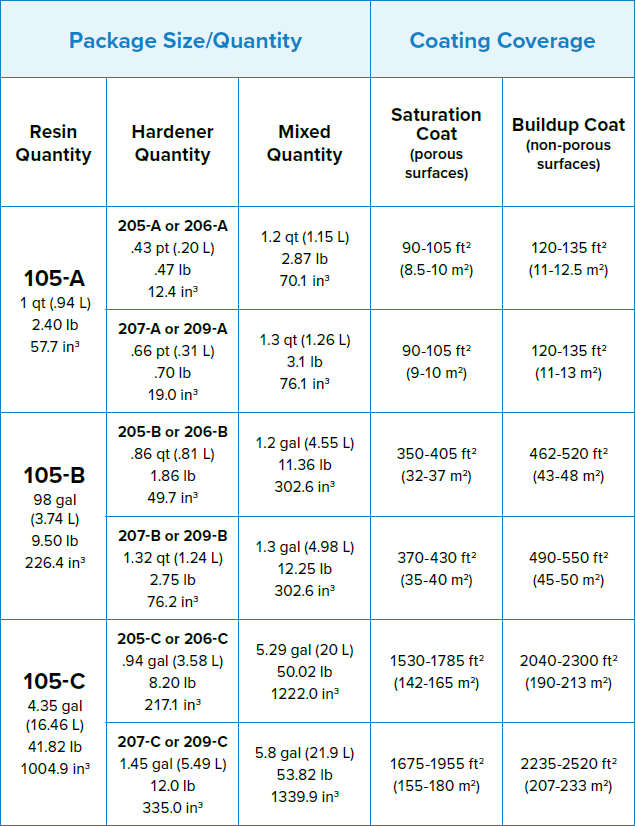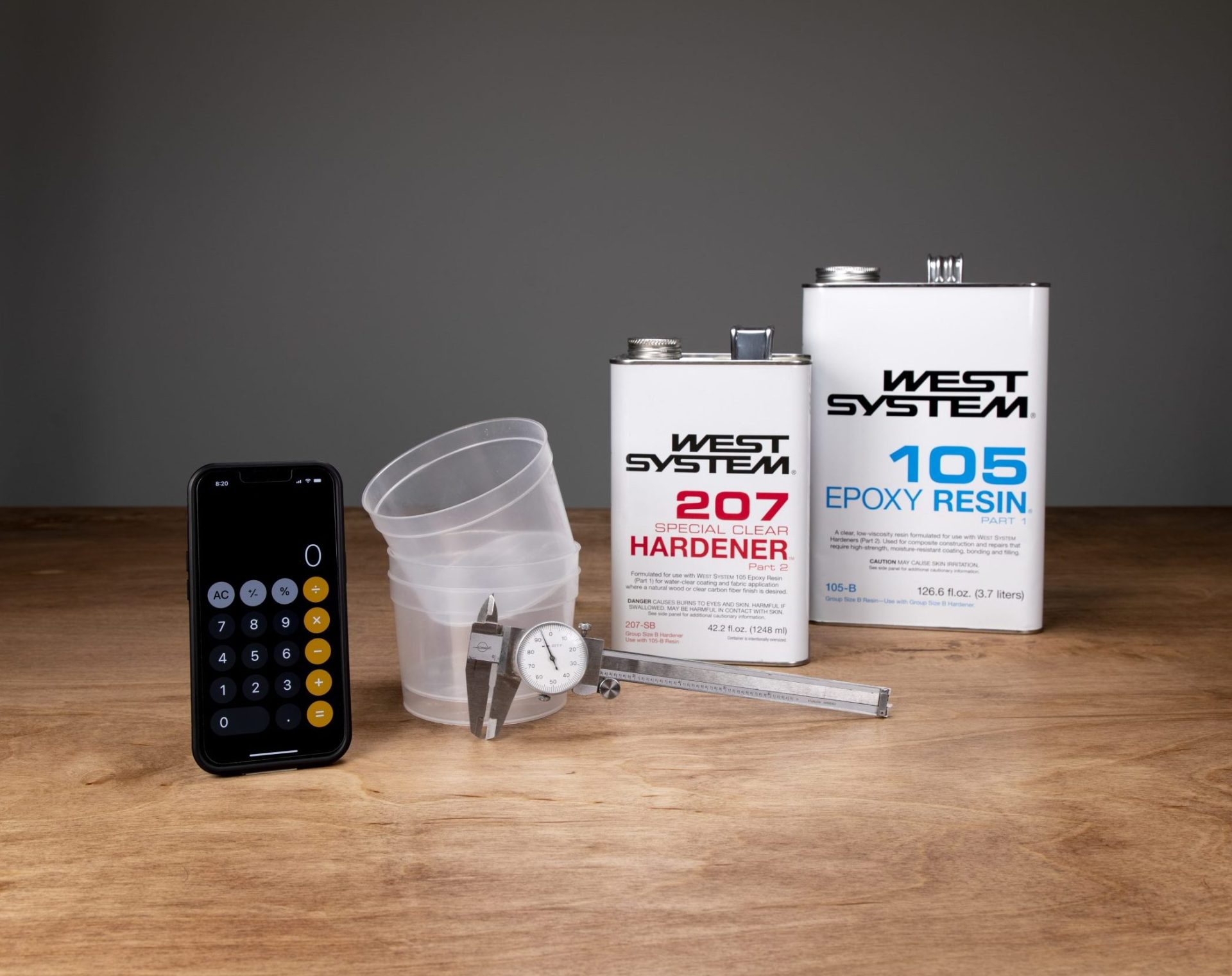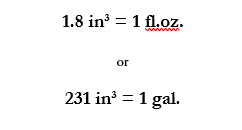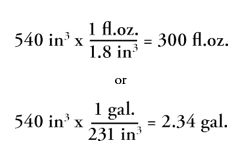
By Terry Monville – GBI Technical Advisor
Knowing how much epoxy you will need for a project before you start will save time, money, and frustration. Luckily, it is fairly simple to get a ballpark idea of how much epoxy your project will require before you start mixing.
Calculating the Amount of Mixed Resin and Hardener
The first thing we need to do is calculate the volume of your project that needs epoxy. The formula to calculate cubic inch is length x width x depth. It’s pretty straightforward, but let’s use it in an example. Say you want to coat a bar top with a ¼” deep coating of WEST SYSTEM® 105 Epoxy Resin® and 207 Special Clear Hardener™. The bar top is 6′ long (72″) and 2 ½’ wide (30″). To calculate the volume of the coating, we multiply these dimensions together. It’s important to be sure your units all match before beginning your calculations. In this case, we’re going to stick with inches.
72 in x 30 in x 0.25 in = 540 in3
Length x Width x Depth = Volume
Now that we’ve calculated the area that needs epoxy, it’s time to convert that into a more useable number, ounces. Here’s the conversion that will help get us there:
Since we now know our total volume, 540 in3, we can calculate how much liquid is needed to fill that volume. We simply divide the number of cubic inches for our project by the number of cubic inches in either a fluid ounce or a gallon.
This gives us the total amount of mixed resin and hardener we need to fill the required volumes for our fictional bar top project.
How Much Resin and Hardener Should I Buy?
Now that we know the volume of mixed epoxy required for our project, it is an excellent time to explain the WEST SYSTEM group sizes. The group sizes are based on the size of the 105 Epoxy Resin containers. The corresponding group size hardeners are adjusted according to mix ratio so you use up all the resin and hardener in the containers at the same time.
An A Group of resin has a quart of 105, a B Group has a gallon of 105, and a C Group has 4.3 gallons of 105 Epoxy Resin. Then you buy the 200 series hardener from the same group size. For example, if you want to purchase a 105-B and 207 hardener, you would need to purchase the 207-SB. The last letter in the part number indicates the group size giving you the appropriate amount of hardener for the resin.
205 Fast Hardener® and 206 Slow Hardener® are mixed with the 105 Epoxy Resin at 5 parts resin to 1 part hardener by volume. The 207 Special Clear Hardener and 209 Extra Slow Hardener® are mixed at 3 parts resin to 1 part hardener by volume. Since the volumetric ratios are different, hardeners of the same group size will have a different amount of total mixed epoxy.
For our bar top, we need 2.34 gallons of mixed 105/207. We usually factor in around an additional 10% for waste, to account for epoxy left in the bottom of cups and soaked up by roller covers. This puts us at around 2.57 gallons of mixed epoxy needed. You can see in the chart that two B Groups of 105/207 would give you 2.6 gallons or 604 in3 of mixed epoxy.
The coverage information in this chart can also be found on the side of the resin cans. This makes picking your group size easier when shopping. The coverage is based on one layer of epoxy rolled out using a WEST SYSTEM 800 Roller Cover, applied using the roll and tip method. On a non-porous surface, this will give you a layer about 4 mils thick. Mils is a measurement of film thickness. One mil is equal to 0.001″. If you do the math on an A group of 105/206, 121 ft2, 0.004″ deep, it works out to 70 in3or 39 fl.oz. of epoxy.

Coverage will vary depending on how hard you press down on the roller, the temperature of the epoxy, and the porosity of the surface. In cooler weather, the epoxy will be thicker and not as easy to roll out to 4 mils. The thicker the coating, the fewer square feet of coverage, and the more likely it will be to run or sag on a vertical surface. The more porous the surface, the thinner the first coat will be.
How Fillers Affect Coverage
How does adding fillers affect the volume of mixed epoxy? With our 403 Microfibers, 404 High-Density, 405 Filleting Blend, and 406 Colloidal Silica, you will have slight volume increases, but not enough to worry about for estimating. This is because these fillers tend to be wet out by epoxy.
Working with 407 Low-Density Filler and 410 Microlight® is a different story. These fillers are particles that take up space in the mixture and lower the density. Let’s say we’re working with an A Group of 105/206—70 in3 of epoxy. If we thicken the entire batch with 407 to a peanut butter thickness, it will give us 2.2 times the volume of the neat epoxy or 154 in3 of thickened epoxy. This will cover 4.3 ft2 at a thickness of ¼”. This would be handy to know if you were planning on fairing your keel or other repairs.
Using 410 to thicken an A Group of 105/206, you would see the neat epoxy expand 2.5 times, yielding 175 in3 of thickened epoxy. This would cover 4.8 ft2 at ¼” thick.
Buying more than needed is not a big issue for epoxy, it keeps, but it might be more money than you wanted to spend. On the other hand, not purchasing enough is always inconvenient and time-consuming. By calculating out how much epoxy you need in advance, you can ensure you hit that happy medium of not running short or breaking the bank.
Package Size/Quantity |
Coating Coverage |
|||
Resin Quantity |
Hardener Quantity |
Mixed Quantity |
Saturation Coat(porous surfaces) |
Buildup Coat (non-porous surfaces) |
105-A1 qt (.94 L) 2.40 lb 57.7 in3 |
205-A or 206-A.43 pt (.20 L) .47 lb 12.4 in3 |
1.2 qt (1.15 L) 2.87 lb 70.1 in3 |
90-105 ft2 (8.5-10 m2) |
120-135 ft2 (11-12.5 m2) |
207-A or 209-A.66 pt (.31 L) .70 lb 19.0 in3 |
1.3 qt (1.26 L) 3.1 lb 76.1 in3 |
90-105 ft2 (9-10 m2) |
120-135 ft2 (11-13 m2) |
|
105-B98 gal (3.74 L) 9.50 lb 226.4 in3 |
205-B or 206-B.86 qt (.81 L) 1.86 lb 49.7 in3 |
1.2 gal (4.55 L) 11.36 lb 302.6 in3 |
350-405 ft2 (32-37 m2) |
462-520 ft2 (43-48 m2) |
207-B or 209-B1.32 qt (1.24 L) 2.75 lb 76.2 in3 |
1.3 gal (4.98 L) 12.25 lb 302.6 in3 |
370-430 ft2 (35-40 m2) |
490-550 ft2 (45-50 m2) |
|
105-C4.35 gal (16.46 L) 41.82 lb 1004.9 in3 |
205-C or 206-C.94 gal (3.58 L) 8.20 lb 217.1 in3 |
5.29 gal (20 L) 50.02 lb 1222.0 in3 |
1530-1785 ft2 (142-165 m2) |
2040-2300 ft2 (190-213 m2) |
207-C or 209-C1.45 gal (5.49 L) 12.0 lb 335.0 in3 |
5.8 gal (21.9 L) 53.82 lb 1339.9 in3 |
1675-1955 ft2 (155-180 m2) |
2235-2520 ft2 (207-233 m2) |
|
Want To Learn About West System Fillers? Take a look at our Filler Selection Guide.







